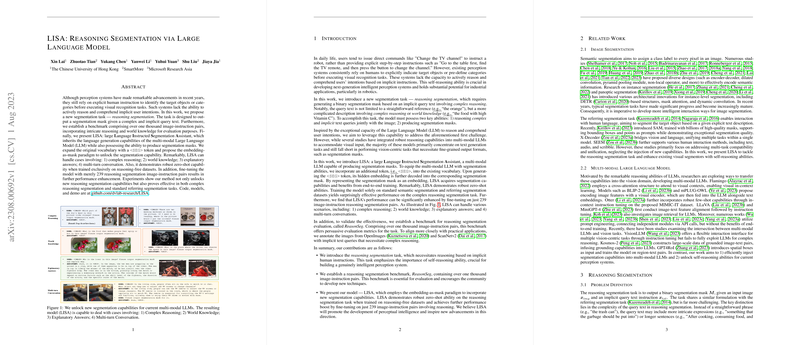Analysis of "LISA: Reasoning Segmentation via LLM"
This paper, titled "LISA: Reasoning Segmentation via LLM," presents an advanced framework for segmentation tasks that necessitates intricate reasoning and comprehension beyond explicit human instructions. The authors identify a significant limitation in current perception systems, which typically require explicit user input to identify target objects or categories. In response, they propose the novel task of reasoning segmentation, aiming to generate a binary segmentation mask from implicit and complex query texts.
Key Contributions
The paper's significant contributions can be summarized as follows:
- Introduction of Reasoning Segmentation Task: The authors delineate a new segmentation task that requires generating a segmentation mask based on implicit and complex query texts. This task is fundamentally different from traditional referring segmentation tasks, which rely on explicit descriptions.
- ReasonSeg Benchmark: To validate their approach, the authors construct the ReasonSeg benchmark consisting of over 1000 image-instruction pairs. This benchmark serves as a comprehensive evaluation metric, promoting further research in the domain.
- LISA Model: They develop the Large Language Instructed Segmentation Assistant (LISA), integrating the reasoning capabilities of multi-modal LLMs with segmentation abilities. Noteworthy is the embedding-as-mask paradigm enabling LLMs to produce segmentation masks.
- Zero-shot and Fine-tuning Capabilities: LISA exhibits strong zero-shot performance on reasoning segmentation tasks when trained on standard datasets without explicit reasoning segmentation samples. Further performance enhancements are observed with minimal fine-tuning on a small subset of reasoning segmentation pairs.
Methodological Innovations
The proposed LISA model leverages a robust multi-modal LLM (specifically, LLaVA) and incorporates a vision backbone capable of segmentation, such as SAM. The introduction of a new token, <SEG>, into the LLM's vocabulary enables it to produce segmentation masks. Upon generating the <SEG> token, its hidden embedding is decoded into a segmentation mask using an MLP projection layer and a dedicated decoder. This embedding-as-mask technique facilitates a seamless integration of segmentation capabilities into the LLM framework.
Training LISA involves standard semantic segmentation datasets, referring segmentation datasets, and visual question answering datasets. This diversified training regime ensures the model's robustness and efficacy across different tasks, emphasizing the model's ability to generalize and comprehend complex instructions.
Experimental Results
Reasoning Segmentation
LISA significantly outperforms previous methods across various metrics in the reasoning segmentation benchmark. For instance, LISA-13B achieves substantial improvements with an overall gIoU of 44.8% and can be further enhanced to 51.7% with fine-tuning. These results underscore the model’s capability in handling complex queries involving reasoning and world knowledge.
Vanilla Referring Segmentation
In traditional referring segmentation tasks, LISA also demonstrates superior performance. For example, LISA-7B achieves top scores on the refCOCO, refCOCO+, and refCOCOg datasets, outperforming state-of-the-art methods.
Ablation Studies
The extensive ablation studies reveal several critical insights:
- Vision Backbone: SAM, pre-trained on a vast dataset, provides superior results compared to Mask2Former. However, the framework's flexibility allows for various vision backbones.
- Projection Layer: Employing an MLP for the projection layer is beneficial, slightly outperforming a linear projection layer.
- Training Data Diversity: Including multi-class labels and different dataset types during training significantly enhances the performance. The combination of semantic segmentation datasets, referring segmentation datasets, and VQA datasets ensures comprehensive model training.
Implications and Future Work
The innovative embedding-as-mask paradigm presents a robust framework for integrating segmentation capabilities into multi-modal LLMs, paving the way for future research in developing intelligent perception systems capable of handling complex tasks. Such systems have significant potential applications in robotics, where nuanced understanding and execution of tasks based on implicit human instructions are paramount.
Future work could explore extending LISA's capabilities to handle more diverse and complex tasks, potentially involving dynamic and real-time environments. Additionally, enhancing the efficiency of fine-tuning strategies and reducing the computational overhead would be beneficial for broader applications.
In summary, this paper marks a notable advancement in the intersection of LLMs and visual perception tasks, providing a comprehensive framework for reasoning segmentation and setting a benchmark for future research in this domain.
